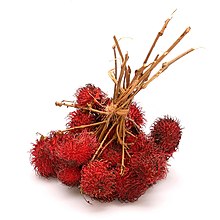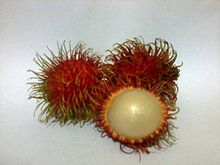Rambutan
| Rambutan | |
|---|---|
 |
|
| Unpeeled and peeled rambutan | |
 |
|
| Rambutan fruits | |
| Scientific classification | |
| Kingdom: | Plantae |
| (unranked): | Angiosperms |
| (unranked): | Eudicots |
| (unranked): | Rosids |
| Order: | Sapindales |
| Family: | Sapindaceae |
| Genus: | Nephelium |
| Species: | N. lappaceum |
| Binomial name | |
|
Nephelium lappaceum L. |
|
| Nutritional value per 100 g (3.5 oz) | |
|---|---|
| Energy | 343 kJ (82 kcal) |
|
20.87 g
|
|
| Dietary fiber | 0.9 g |
|
0.21 g
|
|
|
0.65 g
|
|
| Vitamins | |
| Thiamine (B1) |
(1%)
0.013 mg |
| Riboflavin (B2) |
(2%)
0.022 mg |
| Niacin (B3) |
(9%)
1.352 mg |
| Vitamin B6 |
(2%)
0.02 mg |
| Folate (B9) |
(2%)
8 μg |
| Vitamin C |
(6%)
4.9 mg |
| Minerals | |
| Calcium |
(2%)
22 mg |
| Iron |
(3%)
0.35 mg |
| Magnesium |
(2%)
7 mg |
| Manganese |
(16%)
0.343 mg |
| Phosphorus |
(1%)
9 mg |
| Potassium |
(1%)
42 mg |
| Sodium |
(1%)
11 mg |
| Zinc |
(1%)
0.08 mg |
|
|
|
|
|
| Percentages are roughly approximated using US recommendations for adults. Source: USDA Nutrient Database |
|
The rambutan (/ræmˈbuːtən/; taxonomic name: Nephelium lappaceum) is a medium-sized tropical tree in the family Sapindaceae. The name also refers to the edible fruit produced by this tree. The rambutan is native to the Malay-Indonesian region, and other regions of tropical Southeast Asia. It is closely related to several other edible tropical fruits including the lychee, longan, and mamoncillo.
The name 'rambutan' is derived from the Malay-Indonesian languages word for rambut or "hair", a reference to the numerous hairy protuberances of the fruit, together with the noun-building suffix -an. In Vietnam, it is called chôm chôm (meaning "messy hair") due to the spines covering the fruit's skin.
Native to tropical Southeast Asia, rambutan is commonly grown among various countries throughout the region. It has spread from there to various parts of Asia, Africa, Oceania and Central America. The widest variety of cultivars, wild and cultivated, are found in Indonesia and Malaysia.
Around the 13th to 15th centuries, Arab traders that played a major role in Indian Ocean trade introduced rambutan into Zanzibar and Pemba of East Africa. There are limited rambutan plantings in some parts of India. In the 19th century, the Dutch introduced rambutan from their colony in Southeast Asia and Suriname in South America. Subsequently, the plant spread to tropical Americas, planted in the coastal lowlands of Colombia, Ecuador, Honduras, Costa Rica, Trinidad and Cuba. In 1912, rambutan was introduced to the Philippines from Indonesia. Further introductions were made in 1920 (from Indonesia) and 1930 (from Malaya), but until the 1950s its distribution was limited.
...
Wikipedia


